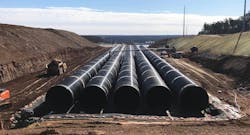Atlanta is one of the fastest-growing markets in the U.S. for IT data center infrastructure. One of the newest data centers in the Atlanta area is in Lithia Springs, GA. Given the nature of the business, not much can be revealed about the site, except that it has a footprint of over one million square feet, generating a massive amount of stormwater runoff.
Naturally, surface detention was the first option engineers explored. The need for a large retaining wall, mosquito vector concerns and poor aesthetics led the project owners to seek an underground solution. Considering the storage volume, over 500,000 CF, the only viable options were corrugated metal pipe or concrete vaults. The engineer specified an underground detention system made from 3,134' of 162" diameter polymer coated corrugated metal pipe (CMP) using VoidSaver™ technology manufactured by Contech Engineered Solutions.
Engineers would typically specify Aluminized Steel Type 2 in applications such as this. However, the owner requested the use of polymer-coated pipe to extend the service life of the system. Polymer-coated pipe is made from galvanized steel with a heavy-gauge polymer coating, which protects against abrasion and corrosion. According to a 2012 study performed by the National Corrugated Steel Pipe Association (NCSPA), polymer-coated CMP provides a 100-year service life in most environmental conditions.
This system also used Contech's patented VoidSaver technology that protects stone void space from solids contamination and leverages stone detention storage to allow for smaller system footprints. The key to the technology is a specially designed overflow vent. As water fills the gasketed system, trash, debris, and suspended solids settle within the solid pipe rather than filling the stone void space and compromising the system. During large events, water fills the pipe, and the water discharges into the surrounding stone via the overflow vent. After the storm subsides, water within the pipe continues discharging, creating differential head pressure between the water within the pipe and water within the stone. This external driving head opens the one-way water return valves, allowing the pipe and stone to fully drain down together.
The extra storage capacity within the stone allowed engineers to design a system with about a 10% smaller footprint while not exceeding the post-construction peak flows for all recurrence intervals required. In addition, the system was designed so that it would not utilize the stone storage until the 25-year storm event to provide long-term protection of the stone storage space.
Designing a system of this size is one thing. Manufacturing it, transporting it, storing it on an active construction site, and installing it is another. Shipping this 162" diameter CMP system would require hundreds of trucks with oversize permits and escort freight costs. It would also create logistical issues that had the potential to slow the installation and add to an already busy jobsite. To eliminate these issues, Contech's MOBILE-PIPE mill was used to manufacture the pipe on-site.
The design and construction team met with the owners every other week during a six-month design process developing storage calculations and multiple design iterations. When it came time to manufacture and install the system, a full pre-construction meeting took place at the job site with the contractor. Several additional on-site meetings with the owner, general contractor, and subcontractor were held throughout the installation, including a post-installation structural inspection by Contech personnel to ensure mechanical integrity and VoidSaver functionality.
The key to the project's success was built on the knowledge and experience of Contech Stormwater Engineers’ combined with a strong working relationship with the owner, general contractor and subcontractor. Together they designed, manufactured and installed a system that will protect the site for over 100 years.


